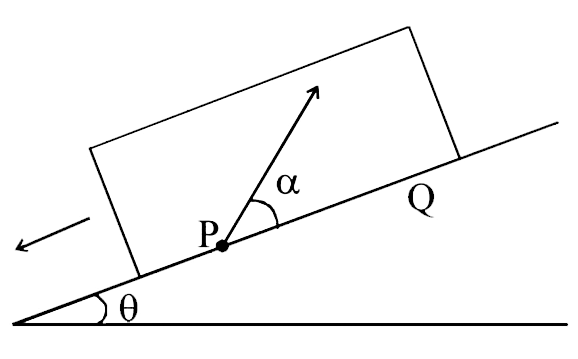A particle starts sliding down a frictionless inclined plane. If Sn is the distance travelled by it from time t=n−1sec, to t=nsec, the ratio Snsn+1 is
2n−12n
2n+12n−1
2n−12n+1
2n2n+1
The correct Answer is:C
Sn=u+a2(2n−1)=a2(2n−1)
S(n+1)=x+a2(2n+1)=a2(2n+1)
⇒SnSn+1=(2n−1)(2n+1)
Topper's Solved these Questions
- BOOK - ALLENCHAPTER - KINEMATICSEXERCISE - MCQ with one or more than one correct Question1videos
KINEMATICS
- BOOK - ALLENCHAPTER - KINEMATICSEXERCISE - SUBJECTIVE QUESTION3videos
KINEMATICS
- BOOK - ALLENCHAPTER - KINEMATICSEXERCISE - Exercise-05 [A]11videos
KINEMATICS
- BOOK - ALLENCHAPTER - ERROR AND MEASUREMENTEXERCISE - Part-2(Exercise-2)(B)22videos
ERROR AND MEASUREMENT
- BOOK - ALLENCHAPTER - KINEMATICS (MOTION ALONG A STRAIGHT LINE AND MOTION IN A PLANE)EXERCISE - BEGINNER S BOX-78videos
KINEMATICS (MOTION ALONG A STRAIGHT LINE AND MOTION IN A PLANE)
Similar Questions
The coordinate of a particle moving in a plane are given by x(t)=acos(pt)andy(t)=bsin(pt) where a,b(<a) and P are positive constants of appropriate dimensions . Then
04:45View SolutionA large , heavy box is sliding without friction down a smooth plane of inclination θ . From a point P on the bottom of the box , a particle is projected inside the box . The initial speed of the particle with respect to the box is u , and the direction of projection makes an angle α with the bottom as shown in Figure .
(a) Find the distance along the bottom of the box between the point of projection p and the point Q where the particle lands . ( Assume that the particle does not hit any other surface of the box . Neglect air resistance .)
(b) If the horizontal displacement of the particle as seen by an observer on the ground is zero , find the speed of the box with respect to the ground at the instant when particle was projected .
 07:37View Solution
07:37View SolutionA ball whose kinetic energy is E , is projected at an angle of 45(∘) to the horizontal . The kinetic energy of the ball at the highest point of its flight will be
05:56View SolutionA cube has a side of length 1.2×10−2m. Calculate its volume.
05:25View SolutionA football player kicks a ball at ball at an angle of 300 with the horizontal with an initial speed of 20m/s. Assuming that the ball travels in a vertical plance, calculate (a) the time at which the ball reaches the highest point (b) maximum height reached (c ) the horizrontal range of the ball (d) the time for wich the ball is in air. g=10m/s2.
05:25View SolutionLet Sn=1+2+3++n and Pn=S2S2−1⋅S3S3−1⋅S4S4−1⋅⋅⋅SnSn−1 Where n∈N,(n≥2). Then limx→∞Pn=______
03:01View SolutionS_(n)=sum_(n=1)^(n)(n)/(1+n^(2)+n^(4)) then S_(10)S_(20)
05:15View SolutionLet Sn,n=1,2,2.... be the sum of infinite geometric series whose first term is n and the common ratio is . 1n+1.Evaluate Limn→∞S1Sn+S2Sn−1+S3Sn−2+.....+SnS1S21+S22+....+S2n
05:08View SolutionA particle starts sliding down a frictionless inclined plane. If Sn is the distance travelled by it from time t=n−1sec, to t=nsec, the ratio Snsn+1 is
05:08View SolutionA small block slides without friction down an iclined plane starting form rest. Let Sn be the distance traveled from time t=n−1 to t=n. Then SnSn+1 is:
07:21View Solutionएक छोटा गुटका एक चिकने आनत तल पर समय t=0 पर विरामावस्था से फिसलता है । माना समय-अन्तराल t=n−1 से t=n में गुटके द्वारा चली गयी दूरी sn है । तब, अनुपात sn/sn+1 है :
02:54View SolutionLet Sn,n=1,2,3,… be the sum of infinite geometric series, whose first term is n and the common ratio is 1n+1. Evaluate limn→∞S1Sn+S2Sn−1+S3Sn−2+...+SnS1S21+S22+......+S2n.
03:38View Solutionएक वस्तु एक घर्षणरहित नत समतल पर प्रारम्भिक विरामावस्था से नीचे ओर सरकती है। यदि sn और sn+1 क्रमशः वस्तु द्वारा n वें और (n+1) वें सेकण्ड में चली गई दूरियाँ हो तो sn+1sn अनुपात है
03:12View Solutionएक वस्तु एक घर्षणरहित नत समतल पर प्रारम्भिक विरामावस्था से नीचे ओर सरकती है। यदि sn और sn+1 क्रमशः वस्तु द्वारा n वें और (n+1) वें सेकण्ड में चली गई दूरियाँ हो तो sn+1sn अनुपात है
08:13View SolutionA small cube falls from rest along a frictionless inclined plane. If this distance travelled between times t = n -1 and t = n be s_(n) then the value of (s_(n))/(s_(n)+1) is
02:12View SolutionA small block slides without friction down an inclined plane starting from rest. Lets sn be the distance travelled from time t=n - 1 to t = n. Then Snsn+1 is:
02:27View Solution

